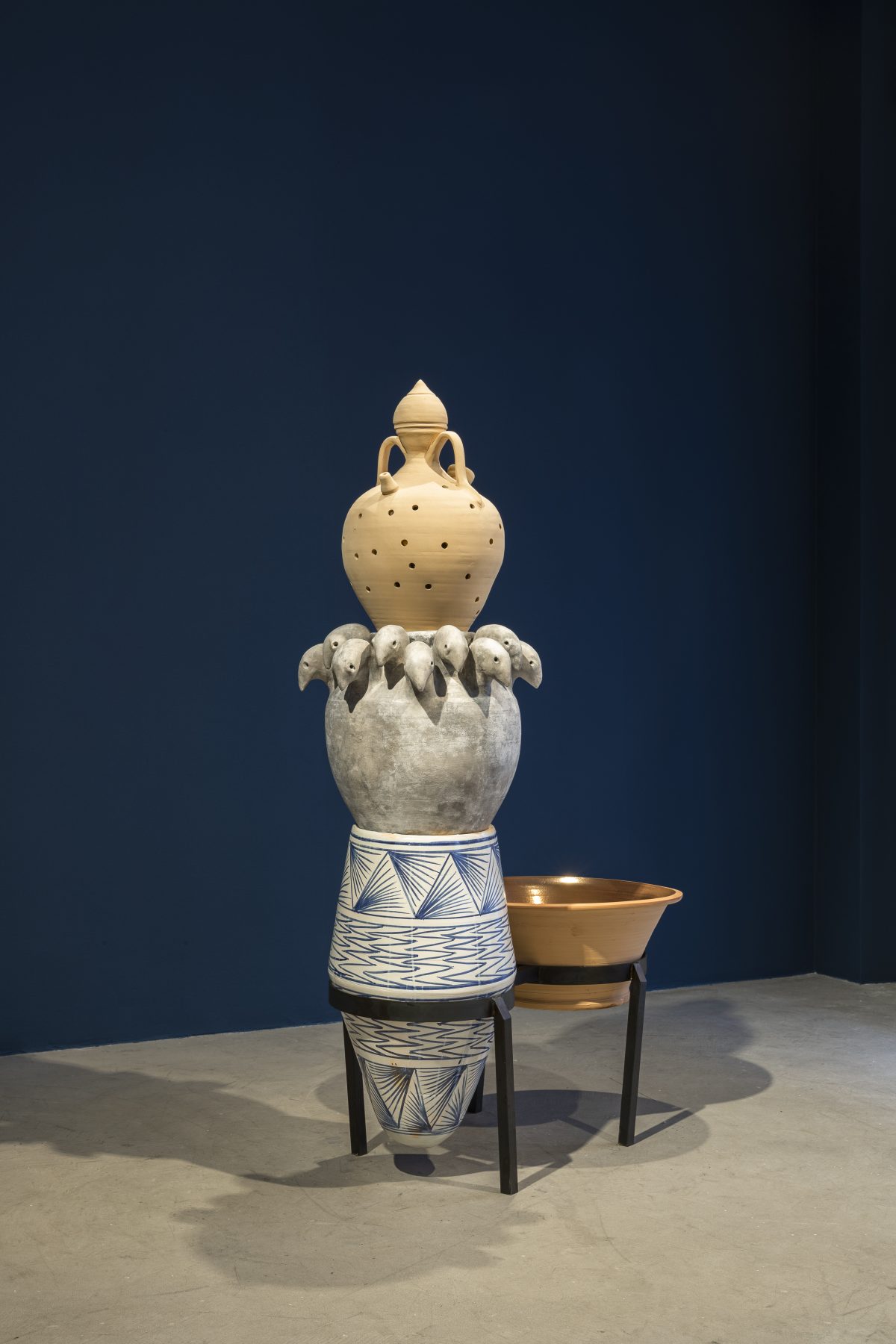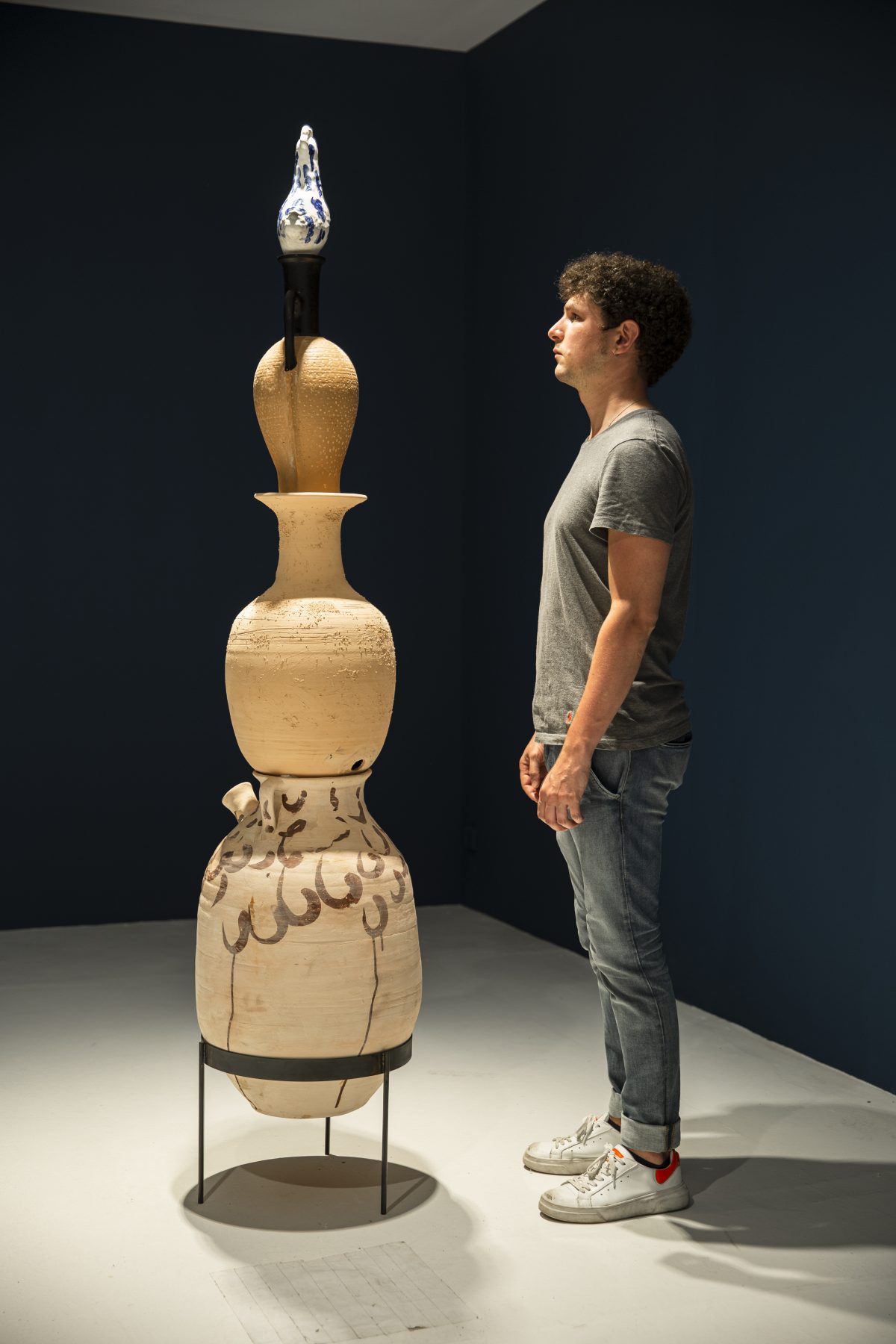
Asunción Molinos Gordo’s latest exhibition at Galería Travesía Cuatro in Madrid makes monuments out of the vessels that were once used to carry, store, and consume water. Blending folklore and fine art, ¡Cuánto río allá arriba! (How many rivers above!) presents a series of pillar-like sculptures composed of ceramic pitchers, jugs, canteens, and basins, all executed in centuries-old designs typical of the Iberian Peninsula and the Mediterranean.
Vessels like the ones in Molinos Gordo’s structures were once essential tools of daily life, but today they’re more often seen in museums. As climate change and globalization continue to take hold of our world, the artist’s assemblages remind us of an agrarian, artisanal past before the arrival of modern running water systems, when these handmade objects tied us more closely to the earth and to our eternal search for clean water.

All of the objects in the exhibition were created by contemporary artisans from Manises, Spain, a town that served as an important hub for Hispano-Moresque wares during the Middle Ages and the Renaissance. This isn’t the first time that Molinos Gordo has resurrected the past through her work: the artist’s recent projects have reconstructed ancient irrigation systems in Moorish Valencia and documented Segovian shepherds’ traditional methods of weather forecasting. However, this project takes a less ethnographic course, isolating the historical object from its usual context and provoking unexpected results.

For example, Molinos Gordo’s stacked exquisite corpses draw fresh attention to the vessels’ diverse forms, inventive shapes, and elegant decorative motifs. The sculptures stand at roughly the visitor’s height, and their smooth surfaces and flesh-colored clays invite our touch. While these features remind us of the close relationship that these sorts of objects once shared with the human body, their vertical configurations also recall the sacrality of a totem pole.
“It’s not a coincidence that many different unrelated cultures have come to produce the same icon, piling things on top of each other, aiming to pay tribute to a story, family, people, [and] spirit that is multilayered and of a magnitude difficult to embrace at once,” Molinos Gordo said in an email to Hyperallergic.
Each of the vessels within the sculptures is unique, its form carefully adapted to a specific kind of water use. Some are utilitarian and unadorned, while others feature elaborate glazes and frilled lines. Molinos Gordo includes ceremonial vessels like a botijo de engaño (jug of deception), which features multiple false drinking spouts as well as a single functional one, and a jarra de novia (bride’s jug), which splashes all of those around the drinker with its many spouts. These playful, interactive vessels were used in weddings and other celebrations to express a sense of communal abundance.
Others reach farther back into history. The shining vessels with elaborately painted, copper-toned surfaces replicate Nasrid pottery, a style that flourished during Spain’s centuries under Moorish rule. Molinos Gordo has lived between Egypt and Oman for nearly 10 years, an experience that has inspired her to raise questions about Spain’s Muslim history and its complicated, often-overlooked role in the culture that many Spaniards claim today.
The exhibition takes its name from a line from Octavio Paz’s 1958 poem “Cántaro Roto” (Broken Pitcher). The poem laments the false promises of modern progress, something Molinos Gordo knows on a personal level. She grew up in a farming family in north-central Spain, where the arrival of new agricultural methods inflicted deep, irreversible changes on her community’s way of life. “I witness[ed] from a very young age the dreadful effects of the industrialization of farming and its consequences in the erasure of rural cultures,” she said by email. Her latest exhibition is a less literal take on preserving agricultural history and culture than her previous works, but not less potent.



Asunción Molinos Gordo: ¡Cuánto río allá arriba! continues at Galería Travesía Cuatro (Calle de San Mateo, 16, Madrid) through July 31.
0 Commentaires